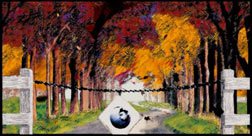An article posted in last week's NY Times has been gnawing at me all weekend. It cites a study performed by two Israelis & a "leading American expert on the psychology of motivation." The single-page piece is titled » "When a Parent's Love Comes with Conditions" .. or » "When 'I Love You' means 'Do as I Say'."
 The article can be summed with the following quote:
The article can be summed with the following quote:
"The primary message of all types of conditional parenting is that children must earn a parent's love. A steady diet of that, Rogers warned, and children might eventually need a therapist to provide the unconditional acceptance they didn't get when it counted."
Doesn't it seem odd that a study was required to determine that rationing of love & acceptance (like gasoline during a shortage) based on 'performance' .. is detrimental to children? Duh.
First, conditional love is not love. Let's call it by its real name » manipulation. And it's the worst kind of manipulation, cuz children, especially young ones, are at the mercy of their parents.
Moreover, they do not yet possess the skills necessary to recognize and defend against such insidious tactics .. from people they're so dependent upon (for eveything).
Now, do you know anyone who enjoys being manipulated? Cuz I don't. Heck, even people who enjoy pain don't like being manipulated. Cuz it doesn't really hurt; it just feels slimy. [Speaking of slime & pain, refer to my comments about boiling a frog near the end.]
Not very difficult to tell the difference, either. Kids (who happen to be particularly sensitive) can spot a fake all-the-way across the coffee shop and will turn away .. while gravitating wholeheartedly to the genuine. You can actually observe this play out.
There are many things a parent can use as leverage to encourage (or discourage) a particular behavior. But love should never be included in the leverage toolkit. Same goes for affection & attention .. things too precious to be used as mere bargaining chips.
Withholding love & affection based on behavior is cruel. Sure, it might elicit the desired response .. in the short term. But the child will grow to resent it (.. as does anybody who's being manipulated). Used consistently and frequently enough, it will instill deep-seated feelings of inadequacy .. that may never go away. (You might even know someone like this .. with deformed self-esteem.)
Many times, when a child is acting out, I'd wager it's *because* he or she is not getting the emotional support they need (from a parent). That would be like telling a hungry child » "Stop fussing or I won't give you any food."
[ In the military, we had a saying » "The beatings will continue until morale improves." Same principle. ]
Whichever side of the great nature vs nurture debate you tend to favor, you always return to » the parents .. as the prime causal agent for how a child turns out .. whether it be on count of their genes or their parenting methods (.. or a combination of both).
We were all kids once. (Well, most of us.) So we all have many years of first-hand experience from which to derive our opinions .. of what works, and what doesn't (.. and what really suks). My point is, it's not rocket science.
 I was excited (.. even more than he was) .. running alongside, shouting » "Oh my God! You're riding!" Waiving my arms like an idiot.
I was excited (.. even more than he was) .. running alongside, shouting » "Oh my God! You're riding!" Waiving my arms like an idiot. National Geo says »
National Geo says »  The
The ![Reblog this post [with Zemanta]](http://img.zemanta.com/reblog_e.png?x-id=243cb0e5-a595-427d-8989-b3c70a91a678)
 There are 4 different '
There are 4 different ' So I'm riding my
So I'm riding my  I.
I.  I endeavor to work on it a little every day, tho it never works like that. Yet when I focus, I'm able to put
I endeavor to work on it a little every day, tho it never works like that. Yet when I focus, I'm able to put  Haven't had a dream where I lose
Haven't had a dream where I lose 